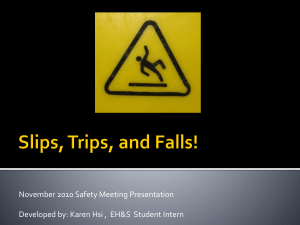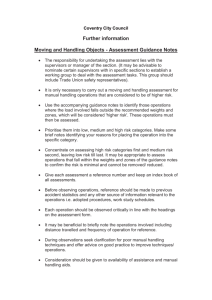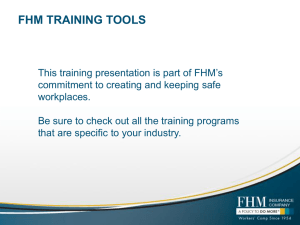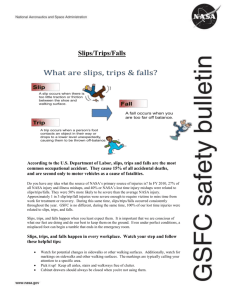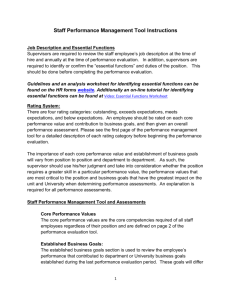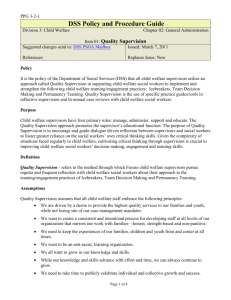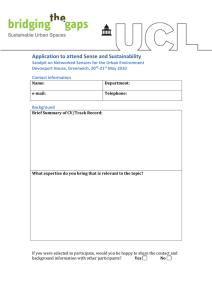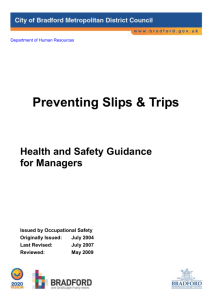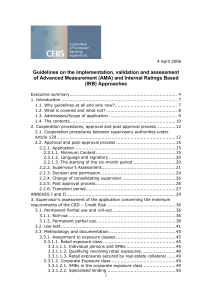Early Years Play Risk Assessment
advertisement
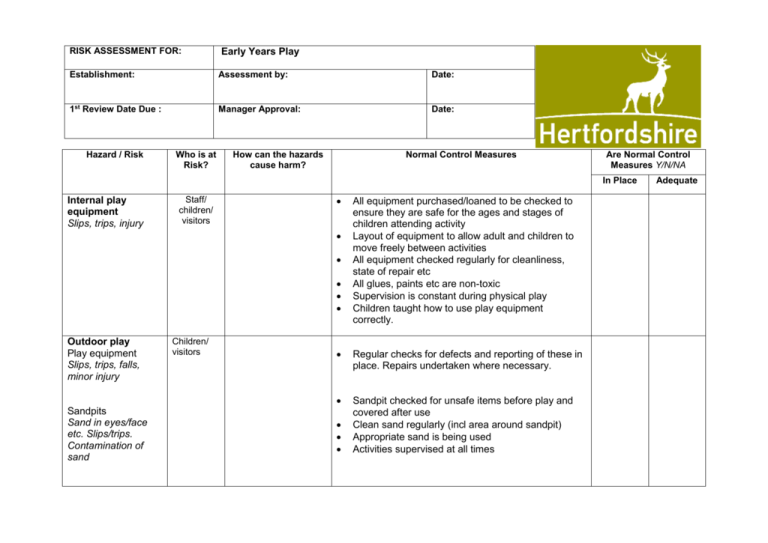
RISK ASSESSMENT FOR: Early Years Play Establishment: Assessment by: Date: 1st Review Date Due : Manager Approval: Date: Hazard / Risk Who is at Risk? How can the hazards cause harm? Normal Control Measures Are Normal Control Measures Y/N/NA In Place Internal play equipment Slips, trips, injury Staff/ children/ visitors Outdoor play Play equipment Slips, trips, falls, minor injury Sandpits Sand in eyes/face etc. Slips/trips. Contamination of sand Children/ visitors All equipment purchased/loaned to be checked to ensure they are safe for the ages and stages of children attending activity Layout of equipment to allow adult and children to move freely between activities All equipment checked regularly for cleanliness, state of repair etc All glues, paints etc are non-toxic Supervision is constant during physical play Children taught how to use play equipment correctly. Regular checks for defects and reporting of these in place. Repairs undertaken where necessary. Sandpit checked for unsafe items before play and covered after use Clean sand regularly (incl area around sandpit) Appropriate sand is being used Activities supervised at all times Adequate Falls from climbing apparatus / major injury Bullying / stress, physical injury HGfL: Healthy & Well Being: Antibullying Fighting/ Rough games / injury Security/ Children absconding/leaving grounds unobserved Unsupervised contact with adults /abduction, assault, child protection issues Restrict and control numbers on apparatus at one time (specify the maximum number of children) Ensure that the equipment is appropriate for the age of the pupils using it. (For some equipment it may be necessary to identify an age or height restriction). Supervision of use required at all times Apparatus not to be used when wet and slippery. Clear rules about appropriate behaviour (for example not to hang upside down from monkey bars) Children to wear appropriate footwear Ensure that impact absorbing surfaces are present where there is a significant risk of a fall (not required for climbing equipment below 60cm) An anti-bullying policy should be in place Adult supervisors should be familiar with the policy Training for supervisors in identification and prevention of bullying Supervisors aware of rules on appropriate behaviour Supervisors trained in how to deal with this type of situation Prohibit inappropriate games Procedures in place for the arrival and departure of children (including when children leave early) Maintained, unbreached fencing (no holes or gaps) Points of access onto the site minimised with clearly signed routes to the reception If possible provide alternative routes for visitors which will bypass playing areas. Gates closed / secured during outside activities Avoid children playing in areas out of sight of adults Areas identified as higher risk made “out of bounds” (Identify on a plan) Hard surfaces / steps and steep slopes /slips trips and falls Inadequate response to accidents / more serious injury Weather Food and Drink Supervision levels appropriate for the layout of the site and the play areas, especially in the vicinity of gates and where there are public footpaths through the grounds. (Identify on a plan) Identify any blind spots due to walls, trees, bushes, play equipment, etc. and eliminate/reduce problem by cutting back/down hedging etc Ensure that the play areas are even and well maintained. Any areas which become unsuitable will need to be coned off and placed out of bounds until repairs can be undertaken. Area periodically checked for missing drain covers, uneven surfaces, etc. Games not to be played on steps Ensure these areas are gritted in the winter when there is ice and snow Adequate numbers of supervision to account for emergency situations First aid kits located close by playing areas Trained first aiders present on the site and available at all times Supervisors who do not have first aid training are aware of the action they should take in the event of an injury and what not to do Suitable outdoor clothing (sunhats/wet weather wear) to be worn Sunscreen to be applied by parents where applicable Staff trained to appropriate levels in food hygiene All food and drink is stored appropriately Adults do not carry hot drinks through play area(s) Additional Control Measures (to take account of local/individual circumstances including changes such as working practices, equipment, staffing levels). Action by Whom (list the name of the person/people who have been designated to conduct actions) Action by When (set timescales for the completion of the actions – remember to prioritise them) Action Completed (record the actual date of completion for each action listed) Residual Risk Rating DATE OF REVIEW: Record actual date of review COMMENTS: Record any comments reviewer wishes to make. Including recommendations for future reviews. DATE OF REVIEW: COMMENTS: DATE OF REVIEW: COMMENTS: RESIDUAL RISK RATING VERY HIGH (VH) Strong likelihood of fatality / serious injury occurring HIGH (H) Possibility of fatality/serious injury occurring MEDIUM (M) Possibility of significant injury or over 3 day absence occurring LOW (L) Possibility of minor injury only ACTION REQUIRED The activity must not take place at all. You must identify further controls to reduce the risk rating. You must identify further controls to reduce the risk rating. Seek further advice, e.g. from your H&S Team If it is not possible to lower risk further, you will need to consider the risk against the benefit. Monitor risk assessments at this rating more regularly and closely. No further action required.

